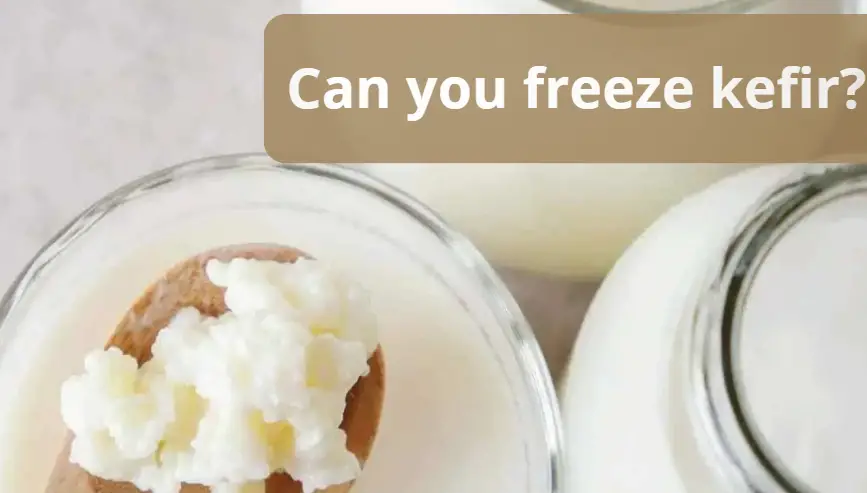
Table of Contents
Can you freeze kefir?
Yes, you can freeze kefir! Freezing kefir is a great way to preserve it if you have more than you can use before it spoils. Here’s how to do it:
How to Freeze Kefir
- Use a Freezer-Safe Container: Pour the kefir into a clean, airtight container, leaving some space at the top for expansion as it freezes.
- Label the Container: Write the date on the container to keep track of how long it’s been frozen.
- Freeze: Place the container in the freezer. Kefir can be frozen for up to 3 months without significant loss of its probiotic properties.
How to Thaw Kefir
- Refrigerator Thawing: Move the frozen kefir to the fridge and let it thaw slowly. This can take several hours or overnight.
- Shake or Stir: After thawing, the texture may change, becoming slightly separated. Stir or shake it well before using.

Notes
- Texture Changes: Freezing can affect the texture, making it thinner or more grainy. While it may not be ideal for drinking on its own, it works perfectly in smoothies, baking, or cooking.
- Probiotic Activity: Most of the probiotics will survive freezing, but some may become dormant. They should reactivate once the kefir is thawed.
Pros and Cons of freezing kefir
- Prolongs Shelf Life:
Kefir typically lasts 1-2 weeks in the fridge. Freezing extends its shelf life up to 3 months. - Prevents Waste:
Freezing allows you to preserve surplus kefir rather than letting it spoil. - Convenience:
Pre-frozen portions are handy for smoothies, recipes, or future use. - Maintains Most Nutrients:
While the texture may change, the vitamins, minerals, and probiotics are largely preserved. Probiotics become dormant but reactivate after thawing. - Versatility After Thawing:
Even if the texture isn’t as smooth, thawed kefir works well in cooking, baking, or blended drinks.
- Texture Changes:
The texture can become thinner, grainy, or separated after thawing. This may not appeal to some for drinking kefir plain. - Potential Loss of Probiotic Activity:
While most probiotics survive freezing, some may not. The live cultures may also take time to reactivate after thawing. - Freezer Space:
Storing kefir in the freezer takes up valuable freezer space, especially if freezing large quantities. - Not Always Ideal for Drinking:
If you enjoy kefir’s fresh, creamy consistency, the post-freezing texture might be less satisfying. - Requires Thawing Time:
You need to plan ahead to thaw frozen kefir, which might not be convenient for spontaneous use.
When to Freeze Kefir
Freezing kefir is ideal if:
- You have excess kefir that might spoil.
- You’re planning to use it in recipes where texture isn’t critical.
- You don’t mind a slight decrease in probiotics and texture changes.
If you prefer kefir for its fresh taste and texture, using it before it expires might be a better choice.
When is Frozen Kefir Best Used?
- Smoothies: Blended recipes mask texture changes.
- Baking or Cooking: Kefir adds tanginess to recipes where texture is less critical.
- Salad Dressings: Thinner consistency can be a benefit
READ ALSO: Can you freeze flan?

FAQs
Does freezing kefir destroy the probiotics?
Freezing kefir does not destroy the probiotics, but it can temporarily render some of them inactive.
What Happens to Probiotics When Kefir is Frozen?
- Dormancy:
- Most probiotics in kefir become dormant during freezing. They are not killed but are inactive until conditions (temperature and moisture) allow them to reactivate.
- Reactivation Upon Thawing:
- Once thawed, many probiotics “wake up” and become active again, provided the kefir is handled properly.
- Survivability:
- Studies suggest that a significant portion of probiotics can survive freezing. However, the survivability may vary depending on the strain of bacteria or yeast and how long the kefir is frozen.
Does freezing kefir affect quality?
Yes, freezing kefir can affect its quality, particularly in terms of texture and taste.
Changes in Quality After Freezing Kefir
1. Texture
- Separation: Freezing can cause the liquid and solid components of kefir to separate. This happens because ice crystals form and disrupt the structure of the proteins and fats.
- Graininess: Once thawed, the kefir may have a grainy or slightly clumpy texture, which can be less appealing for drinking.
- Solution: Shake or stir thawed kefir vigorously to help reintegrate the components.
2. Taste
- Minimal Change: The taste of kefir is generally well-preserved during freezing. However, subtle differences in tanginess may occur depending on storage time.
- Solution: Use thawed kefir in recipes like smoothies or baked goods if the taste feels slightly altered.
3. Probiotic Activity
- Dormancy: While freezing doesn’t destroy probiotics, some strains may become less active or take time to reactivate after thawing.
- Solution: Thaw kefir slowly in the fridge to protect the probiotics as much as possible.
4. Consistency
- Thinner Kefir: The freezing and thawing process often results in a thinner kefir than its original creamy texture.
- Solution: Thawed kefir is still excellent for use in recipes, dressings, or smoothies, where the thinner consistency doesn’t matter.
How to Minimize Quality Loss
- Freeze Quickly: Rapid freezing (e.g., using a deep freezer) reduces the size of ice crystals, minimizing texture changes.
- Use Airtight Containers: Prevents freezer burn and helps preserve the fresh taste.
- Label and Date: Store kefir for no more than 1–3 months for the best quality.
- Thaw in the Fridge: Avoid microwaving or exposing thawed kefir to high heat, which can impact taste and probiotic activity.
Does kefir go bad if frozen?
No, kefir does not go “bad” in the traditional sense when it is frozen, but its quality can decline over time if not stored properly.
